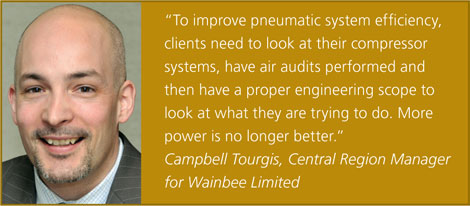
Fluid Power Roundtable ’10
By Mike McLeod
Fluid Power pneumaticsCanadian fluid power leaders discuss the challenges and potential remedies for the industry.
The new technology is looking at better ways to capture some of that energy over a longer period of time, either through accumulators or better designed circuits that can transfer energy from one part to another. That’s going to be very important because we are seeing improvements in efficiency on the electric side but we have to see the same improvements in the hydraulic side.
Samaroo/Festo: For pneumatics, I don’t think it’s any one thing but a combination of little things. Because pneumatics was traditionally a really cheap technology, companies would oversize actuators, valves and everything on the pneumatic size of their design. We have to get back to engineering these components so they are properly sized, which would bring a reduction in air consumption. Also, using lower usage power coils on the values, for example 5 watt coils versus the traditional 20 or half amp coil. It’s also important to look at air system in plant to reduce losses. If you do all of that, you can bring the cost of pneumatic systems down significantly.

Tourgis/Wainbee: To add to that, system design is most important right now. A big initiative in Europe is to reduce pressure requirements. The compressor only needs to run when it is relatively inefficient. Just like in hydraulics, there is a large part to play for clients in North America to look at their compressor system, have air audits performed to reduce leaks and then have a proper engineering scope to look at what they are trying to do. More power is no longer better.
Burton/UofS: I think the issue of hydraulic fluids is very important. Years ago, there was a large thrust toward fire resistant fluids in mining industry in Western Canada, and there was work done on water-based and synthetic fluids. I think the challenge there was that you could get these environmentally friendly fluids but the biggest problem was the sealing: How do you make the seals compatible with the new fluids? I think that is something that is going to have to occur.
Pat Jones, P.Eng., owner of Consolidated Fluid Power Training Ltd. and Technical Services Manager with Strictly Hydraulics: The big unknown is what the time frame will be for getting this research done and getting more efficient components into the design stream; we are still designing hydraulic systems today with components that are 30 years old. There is a lot of newer technology in proportional and servo control, for example, but the basic pumping systems are old technology in a lot of cases. There’s a need for more compact systems as well, especially when you look at the footprint of a hydraulic system plus a reservoir in a manufacturing facility compared to an electric drive with the same horse power.
